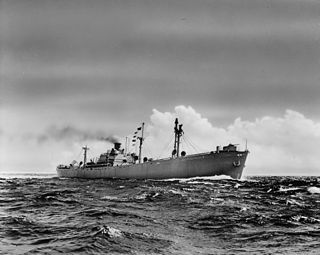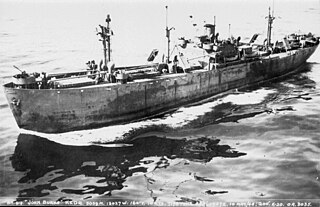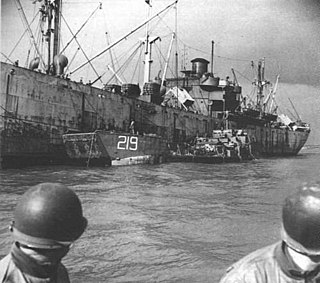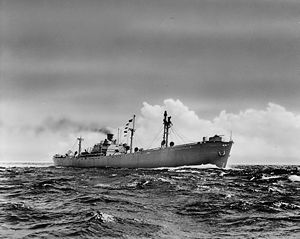
The Victory ship was a class of cargo ship produced in large numbers by American shipyards during World War II to replace losses caused by German submarines. They were a more modern design compared to the earlier Liberty ship, were slightly larger and had more powerful steam turbine engines, giving higher speed to allow participation in high-speed convoys and make them more difficult targets for German U-boats. A total of 531 Victory ships were built in between 1944 and 1946.

Liberty ships were a class of cargo ship built in the United States during World War II under the Emergency Shipbuilding Program. Although British in concept, the design was adopted by the United States for its simple, low-cost construction. Mass-produced on an unprecedented scale, the Liberty ship came to symbolize U.S. wartime industrial output.

USS Salamaua (CVE-96) was a Casablanca-class escort carrier of the United States Navy. She was named after the invasion of Salamaua, a strategically important village in the New Guinea Theater during World War II, and one of the main targets of the Salamaua–Lae campaign. She served with distinction during the war, notably being damaged in early 1945 by a kamikaze aircraft during the Invasion of Lingayen Gulf, killing 15 crewmen and injuring 88. Post war, the ship helped repatriate servicemen to the United States as part of Operation Magic Carpet before being decommissioned and struck in 1946, and ultimately being broken up in 1947.
A ship's hold or cargo hold is a space for carrying cargo in the ship's compartment.
SS Antoine Saugrain was a Liberty ship of the United States that served in World War II. The ship was built at the Permanente Metals Corporation Yard No. 2 in Richmond, California under Maritime Commission Contract 1728. Laid down on 26 July 1943, the ship was launched on 15 August, and delivered on 28 August to Agwilines Inc. She was named after Antoine Saugrain, a French physician and chemist who immigrated to America at the end of the 18th century and led various pioneering works, including on vaccination against smallpox.
SS John P. Gaines was a Liberty ship built during World War II by the Oregon Shipbuilding Corporation, and named for politician John P. Gaines. Northland Transportation Company was chartering the ship from the Maritime Commission and War Shipping Administration that owned the ship as part of the Merchant navy.

SS Marcus Daly was a liberty ship built by the Kaiser Shipyards at their Permanente No.1 yard at Richmond, California, and launched on 24 July 1943.

MS American Leader was a merchant cargo ship which entered service for the United States Lines in 1941. It was most noted for falling victim to the German auxiliary cruiser Michel during the Second World War. Her surviving crew members were taken as prisoners of war and collectively they endured three ship sinkings.

SS John Burke was an American Liberty Ship built during World War II, one of the 2,710 type 'EC2-S-C1' ships that carried all kinds and types of dry cargo during the war. The ship was named for John Burke, the 10th Governor of North Dakota. Burke was built at Kaiser Shipbuilding Company's Oregon Shipbuilding yard in Portland, Oregon. Burke's keel was laid November 20, 1942 and the hull was launched on December 13. After fitting-out, Burke was delivered to the US Maritime Commission on December 23, just 33 days after construction began. The War Shipping Administration then placed Burke under management of the Northland Transportation Company.

The SS Clarksdale Victory was the 80th Victory ship built during World War II. She was launched by the California Shipbuilding Company on January 27, 1945, and completed on February 26, 1945. The ship’s United States Maritime Commission designation was VC2-S-AP3, hull number 80. She was built in just 86 days under the Emergency Shipbuilding program. SS Clarksdale Victory served in the Pacific Ocean during WW2. SS Clarksdale Victory was 80th of the new 10,500-ton class ship known as Victory ships. Victory ships were designed to replace the earlier Liberty Ships. Liberty ships were designed to be used just for WW2. Victory ships were designed to last longer and serve the US Navy after the war. The Victory ship differed from a Liberty ship in that they were: faster, longer and wider, taller, a thinner stack set farther toward the superstructure and had a long raised forecastle.

The SS Canada Victory was one of 531 Victory ships built during World War II under the Emergency Shipbuilding program. She was launched by the Oregon Shipbuilding Corporation on January 12, 1944, and was completed on February 28, 1944. The ship’s United States Maritime Commission designation was VC2-S-AP3, hull number 93 (1009). The Maritime Commission turned her over to a civilian contractor, the Alaska SS Company, for operation.

SS Logan Victory was a cargo Victory ship built for World War II under the Emergency Shipbuilding program. The Logan Victory was launched January 16, 1945, by Permanente Metals Corporation, Richmond, California and completed on February 6, 1945. She was operated by the American-Hawaiian Steamship Company under the United States Maritime Commission.

SS Hobbs Victory was a cargo Victory ship built for World War II under the Emergency Shipbuilding program. Hobbs Victory, was launched on January 9, 1945 by Permanente Metals Corporation, Richmond, California and completed on January 9, 1945. She was built in just 87 days. She was operated by the Sudden & Christenson for the United States Maritime Commission.

The SS Minot Victory was a Victory ship built during World War II under the Emergency Shipbuilding program. She was laid down and launched by the Oregon Shipbuilding Corporation, and completed on February 1, 1945. The ship's United States Maritime Commission designation was VC2-S-AP3 and hull number 149 (1203). The Maritime Commission turned it over for merchant navy operation to a civilian contractor, the Isthmian Steamship Company under the United States Merchant Marine act for the War Shipping Administration. She was named after Minot, Maine and Minot, North Dakota.

The SS Saginaw Victory was a Victory ship built during World War II under the Emergency Shipbuilding program. It was laid down and launched by the Oregon Shipbuilding Corporation, and completed on February 9, 1945. The ship's United States Maritime Commission designation was VC2-S-AP3 and hull number 152. The Maritime Commission turned it over for merchant navy operation to a civilian contractor, the Pacific-Atlantic Steamship Company under the United States Merchant Marine act for the War Shipping Administration. She was named after Saginaw, Michigan. Victory ships were designed to supersede the earlier Liberty ships. Unlike Liberty ships, Victory ships were designed to serve the US Navy after the war and to last longer. Compared to Liberty ships, Victory ships were faster, longer, wider, taller, and had a thinner stack which was set further forward on the superstructure. They also had a long, raised forecastle.

The SS Berea Victory (MCV-734) was a type VC2-S-AP2 Victory-class cargo ship built for the United States during World War II. The ship was built as part of the Emergency Shipbuilding program by Permanente Metals Corporation in Yard 2 of the Richmond Shipyards in Richmond, California. Launched on 3 March 1945, the Berea Victory delivered supplies for the Pacific War.

The SS Pierre Victory was a Victory ship built during World War II under the Emergency Shipbuilding program. It was laid down and launched by the Oregon Shipbuilding Corporation, and completed on February 5, 1945. The ship's United States Maritime Commission designation was VC2-S-AP3 and hull number 150. The Maritime Commission turned it over for merchant navy operation to a civilian contractor, the United States Lines under the United States Merchant Marine act for the War Shipping Administration. She was named after Pierre, South Dakota, the capital of the US state of South Dakota. The sponsor and christening of the SS Pierre Victory on Dec. 6, 1944 was Mrs. Emma S. Jassmann of Pierre, she had five sons who served during World War II,. The city of Pierre and the Pierre Chamber of Commerce sent Mrs. Jassmann to Oregon. The Mayor of City of Pierre, John B. Griffin, was also at the christening with other Pierre residents. She was built in only 98 days. Victory ships were designed to supersede the earlier Liberty ships. Unlike Liberty ships, Victory ships were designed to serve the US Navy after the war and to last longer. Compared to Liberty ships, Victory ships were faster, longer, wider, taller, and had a thinner stack which was set further forward on the superstructure. They also had a long, raised forecastle. SS Pierre Victory survived three separate kamikaze attacks by the Japanese in 1945.

SS Alexander Majors was a Liberty ship built for the United States Maritime Commission during World War II. The ship was named in honor of Alexander Majors an American who with William Hepburn Russell and William B. Waddell founded the Pony Express. The ship was assigned by the War Shipping Administration to Isthmian Steamship Company of New York who operated it throughout World War 2. Alexander Majors was Laid down on 27 December 1943, launched on 20 January 1944 and completed on 4 March 1944, with the hull No. 2262 as part of the Emergency Shipbuilding Program.

SS Benjamin Ide Wheeler was a Liberty ship, a cargo ship during World War II. Built by California Shipbuilding Corporation (Calship) of Los Angeles for the United States Maritime Commission (USMC). Benjamin Ide Wheeler was Calship's 100th ship built. She was sponsored and christened by Mrs. Robert Gordon Sproul, wife of Robert Gordon Sproul President of the University of California system. She was named after Benjamin Ide Wheeler President of the University of California from 1899 to 1919. Her Hull # was 675, she was type EC2-S-C1 ship, built in 50 days as part of the Emergency Shipbuilding Program. Her keel was laid down on 28 October 1942, launched on 27 November 1942 and delivered on 17 December 1942. She was assigned to American-Hawaiian Steamship Company of San Francisco for merchant operation by the War Shipping Administration (WSA).

SS Jeremiah M. Daily was a Liberty ship built for the United States Maritime Commission during World War II. The ship was named in honor of Jeremiah M. Daily, (1871-1924) who was the manager of marine department of the San Francisco Chamber of Commerce. Jeremiah M. Daily inspired Jerry Dooley and the Affairs of Cappy Ricks. The ship was assigned by the War Shipping Administration to American South African Line of New York who operated it throughout World War II. Jeremiah M. Daily was laid down on 18 July 1943, launched on 9 August 1943 and completed on 22 August 1943, with the hull No. 1724 as part of the Emergency Shipbuilding Program, built is 35 days.








